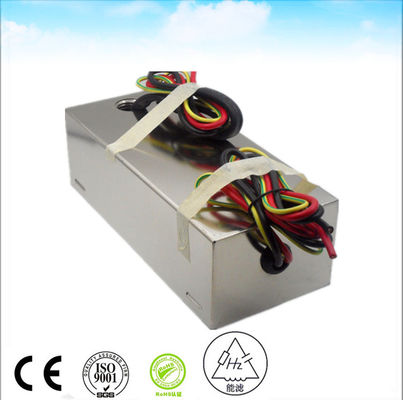-
Highlight
Single Phase emc Filter 25A
,single phase emi filter design
,single phase emc filter design
-
TypeEMI Filter
-
Transfer FunctionLow Pass
-
Package TypeThrought Hole
-
Nominal Center Frequency50/60Hz
-
3dB Bandwidth1
-
Insertion Loss100db
-
Input Impedance50ohm
-
Stopband Attenuation70-100dB
-
Rated Voltage250VAC
-
Rated Current30A
-
LINES NUMBER2
-
ApplicationPOWER LINE FOR MRI FARADAY CAGE
-
PortChangzhou Shanghai Hangzhou Or Others
-
Place of OriginJiangsu, China
-
Brand NameNenglv
-
CertificationCE RoHS
-
Model NumberHZ-2X25A
-
Minimum Order Quantity>=1 Pieces
-
Price$100.00
-
Packaging Details8 PCS IN ONE CARTON THE GROSS WEIGHT OF ONE CARTON IS ABOUT 10KG
-
Supply Ability1000 Piece/Pieces per Week
25A Single Phase EMI Filter Design
Electromagnetic interference (EMI) filters are crucial for a wide range of equipment and devices. Installing an EMI filter helps them function as intended and prevent them from interfering with other devices. Electromagnetic compatibility (EMC) is also a key component of meeting the compliance requirements of global regulations and many industry standards. For EMI filters to provide desired performance, they must be installed correctly. Following best practices for installing EMI filters helps in optimizing their performance and ensures safe compliance margins for the devices.
| RATED VOLTAGE | 250 VAC | ||
| RATED CURRENT | 30 A | ||
| OPERATIONAL FREQUENCY | 50 60Hz | ||
| Voltage Drop | Less than 1V | ||
| Overload | 140% of rated current for 15 minutes | ||
| Harmonic Distortion | Less than 2% @ full rated current | ||
| Leakage Current | ≤0.2A@380/230VAC and 50Hz | ||
| Dielectric Withstanding Voltage | 1000VDC (line to line) 1000VDC (line to case) | ||
| DC Insulation Resistance | As Per MIL-STD-202 Method 202 | ||
| Terminal Strength | As Per MIL-STD-202 Method 211 | ||
| Temperature Rise | As Per MIL-F-15733 | ||
| Insertion Loss: | ≥70dB@150K-10GHz As Per MIL-STD-220A, Under Load Condition | ||
| Climatic Classification | 25/070/21 | ||
While certain best practices apply to almost all EMI filter installations, the installation process for each filter can be slightly different. Because of this variation, be sure to consult the product literature for the EMI filter when installing it or contact application engineering. With that in mind, here are some of the most important recommended installation practices for EMI filters.
The following tips can help ensure proper EMI grounding:
- Use low impedance connections to connect the various parts of the ground system. Flat wires, for instance, offer lower HF impedance than round wires do.
- Ensure that all the ground connections are as short as possible. Consider using a flat, braided ground strap, as these components provide increased surface area.
- Use the largest available area as the ground conductor. The cabinet wall is often a suitable surface.
- Removing paint from mounting surfaces of the cabinets can help achieve a low impedance bond.
- To ensure safety and proper performance, make sure the power system ground is connected to the filter ground termination point before connecting any wires.
- Be sure to research and follow all relevant safety regulations related to grounding.
- Examine all the connections in your low impedance grounding systems as part of your routine maintenance checks.
Our technical team has more than 10 years’ experience in designing EMI filter. We know UL VDE CSA CE CQC etc safety standard very well.
Our technical service team learn many kinds of test standard such as industrial application (IEC61800-3 for frequency inverter drive EN12015 for elevator EN55011 for ISM device etc) and military application (GJB151A GJB152A etc).We can solve EMI problem quickly effectively and low-costly.
2 Stage EMI Filter
230v Ac EMI Filter
240v Ac EMI Filter
3 Phase 400hz EMI Filter
3 Phase RFI Filter
50a EMI Filter
AC Socket EMI Filter With Fuse And Switch
EMI Filter 5A
Ac Dc EMI Filter
Ac Input EMI Filter Design
Ac Line Filter For Audio
Ac Power Line Noise Filter
Anti-Interference Filter
Electromagnetic Interference Filters
EMC EMI Filter For PV Inverters
EMI Electrical Power Filter For Equipment
EMI Filter 10a
EMI Filter 230v
EMI Filter Ac
EMI Filter Feedthrough Capacitor
EMI Filter For Led Lights
EMI Filter For Power Supply
EMI Filter For Vfd
EMI Filter Manufacturers
EMI Filters For Mechanical Equipment
EMI RFI Ac Power Line Filters
EMI RFI Noise Filtration
EMI RFI Noise Suppression Protection Filters
Ethernet EMI Filter
Feedthru Capacitors
General Purpose Socket Emc RFI Noise Filter With Fuse
Gigabit Ethernet EMI Filter
Iec EMI Filters
Inline EMI Filter
Inverter EMI Filter
Laser Cutting Single Phase EMI Filter
Lc EMI Filter
Lcr Electronics EMI Filter
Led EMI Filter
Low Pass EMI Filter
Lvds EMI Filter
Mains EMI Filter
Military EMI Filters
Mri Rf Filter
Passive EMI Filter
Plc Noise Filter
Plug In EMI Filters
Power Filter With Fuse For Medical Equipment
Power Line Filters Single Phase
Power Supply EMI Filter
Radio Frequency Interference Filters
RF Feedthrough Capacitor
RFI Filter For Radio
RFI Filter For Tv
RFI Filter For Vfd
RFI Suppression Filter
Rj45 EMI Filter
Single Phase EMI Filter
Single Phase RFI Filter
Solar Inverter EMI Filter
Three Phase EMI Filters
Vfd EMI Filter
EMI Filter With Rocker Switch And Fuse
Two Stages EMI Ac Power RFI Filter ETC.


